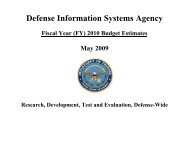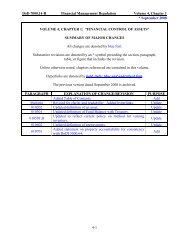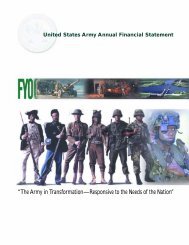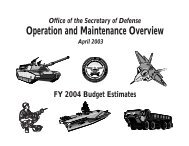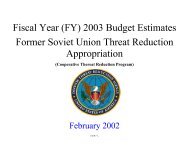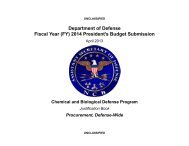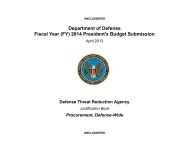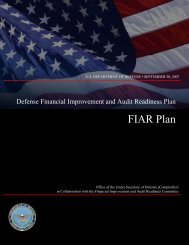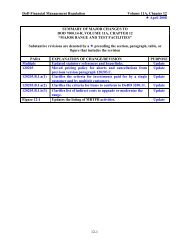Defense Human Resources Activity - Office of the Under Secretary of ...
Defense Human Resources Activity - Office of the Under Secretary of ...
Defense Human Resources Activity - Office of the Under Secretary of ...
You also want an ePaper? Increase the reach of your titles
YUMPU automatically turns print PDFs into web optimized ePapers that Google loves.
UNCLASSIFIED<br />
Exhibit R-2, RDT&E Budget Item Justification: PB 2014 DoD <strong>Human</strong> <strong>Resources</strong> <strong>Activity</strong> DATE: April 2013<br />
APPROPRIATION/BUDGET ACTIVITY<br />
0400: Research, Development, Test & Evaluation, <strong>Defense</strong>-Wide<br />
BA 6: RDT&E Management Support<br />
Project 2: The <strong>Defense</strong> Training <strong>Resources</strong> Analysis. This program transfers to OUSD (P&R) in FY 2013.<br />
R-1 ITEM NOMENCLATURE<br />
PE 0605803SE: R&D in Support <strong>of</strong> DOD Enlistment, Testing and Evaluation<br />
Project 3: DoD Enlistment Processing and Testing. The project administers testing programs, which enable <strong>the</strong> Armed Services to select highly qualified military<br />
recruits. The DoD uses a single test, <strong>the</strong> Armed Services Vocational Aptitude Battery (ASVAB), to determine eligibility <strong>of</strong> military applicants and to report recruit quality<br />
data to Congress. High quality recruits are obtained from administering <strong>the</strong> ASVAB annually to approximately 600,000 applicants for Military Service as part <strong>of</strong> <strong>the</strong> DoD<br />
Enlistment Testing program, and to 1 million students in <strong>the</strong> DoD Student Testing program. Each Service also uses ASVAB test forms developed in this program as<br />
part <strong>of</strong> <strong>the</strong>ir in-service testing programs. New ASVAB test forms and related support materials are implemented approximately every four years. This allows DoD to<br />
make measurement improvements as well as decrease <strong>the</strong> likelihood <strong>of</strong> test compromise. Ongoing RDT&E efforts include development and evaluation <strong>of</strong> procedures<br />
which (1) reduce or eliminate threats to <strong>the</strong> validity <strong>of</strong> <strong>the</strong> ASVAB test scores generated; (2) improve <strong>the</strong> efficiency <strong>of</strong> <strong>the</strong> test development, calibration, and validation<br />
process; and (3) improve selection and classification decisions made by each Service through more effective use <strong>of</strong> test score information. In addition, periodic<br />
assessments are required to provide DoD manpower planners and Congress with information on aptitude trends in <strong>the</strong> population from which recruits are drawn.<br />
Project 4: Federal Voting Assistance Program. Given <strong>the</strong> agile planning and deployment flexibilities required in as dynamic a RDT&E environment as internet voting,<br />
<strong>the</strong> FY 2013 execution plan will be significantly influenced by <strong>the</strong> results <strong>of</strong> <strong>the</strong> FY2011 and FY2012 research, development, and evaluation results. However, current<br />
plans are to initiate <strong>the</strong> first two phases <strong>of</strong> <strong>the</strong> internet voting demonstration competition challenge:<br />
o Phase I <strong>of</strong> Internet Voting Competition Challenge: In <strong>the</strong> first phase submissions will focus on defining security, reliability, usability, and accountability requirements<br />
for internet voting systems. Submissions will be open to <strong>the</strong> public, and will be open to public critique. FVAP will review those submissions and critiques, and <strong>the</strong>n<br />
consolidate <strong>the</strong>m into a single set <strong>of</strong> requirements for Phase II.<br />
o Phase II <strong>of</strong> Internet Voting Competition Challenge: In this phase, submission will provide high level designs and detailed hardware and s<strong>of</strong>tware architectures,<br />
along with procedures necessary for secure operation. Submissions will be sufficiently detailed so that a reasonably skilled information technologist could implement<br />
<strong>the</strong> system to allow for broader peer review. However, many details such as user interfaces and database layouts will be likely be undefined. As with <strong>the</strong> first phase,<br />
submissions will be open for critique. In this phase critiques will focus on identifying areas where designs do not meet <strong>the</strong> requirements defined in <strong>the</strong> first phase.<br />
The result may be modification <strong>of</strong> architectures to incorporate ideas from several teams. At <strong>the</strong> conclusion <strong>of</strong> this phase, <strong>the</strong> Department will narrow down <strong>the</strong> set <strong>of</strong><br />
acceptable architectures.<br />
o RDT&E funding for <strong>the</strong> internet voting program is discontinued in FY 2014 until <strong>the</strong> Election Assistance Commission (EAC) and <strong>the</strong> National Institute <strong>of</strong> Standards<br />
and Technology (NIST) have established <strong>the</strong> measurements and standards against which internet voting can be evaluated.<br />
Project 5: Civilian HR automation enhancements planned for FY 2012 and FY 2013 are focused on s<strong>of</strong>tware development to support <strong>the</strong> Department’s civilian<br />
workforce, including readiness requirements for <strong>the</strong> development <strong>of</strong> automation for an expeditionary civilian workforce; an SES-focused performance management<br />
system; development <strong>of</strong> interfaces with <strong>the</strong> <strong>Defense</strong> Civilian Personnel Data System (DCPDS) and o<strong>the</strong>r civilian HR systems to fully expand <strong>the</strong> Enterprise Staffing<br />
Solution; development <strong>of</strong> DCPDS interfaces with <strong>Office</strong> <strong>of</strong> Personnel Management (OPM) initiative mandates for HR Line <strong>of</strong> Business (LoB), electronic Official<br />
Personnel Folder, Retirement Systems Modernization implementation, and HR Line <strong>of</strong> Business. DoD is one <strong>of</strong> five designated Shared Service Centers in <strong>the</strong> federal<br />
PE 0605803SE: R&D in Support <strong>of</strong> DOD Enlistment, Testing and Eval... UNCLASSIFIED<br />
DoD <strong>Human</strong> <strong>Resources</strong> <strong>Activity</strong> Page 2 <strong>of</strong> 25 R-1 Line #161<br />
12



